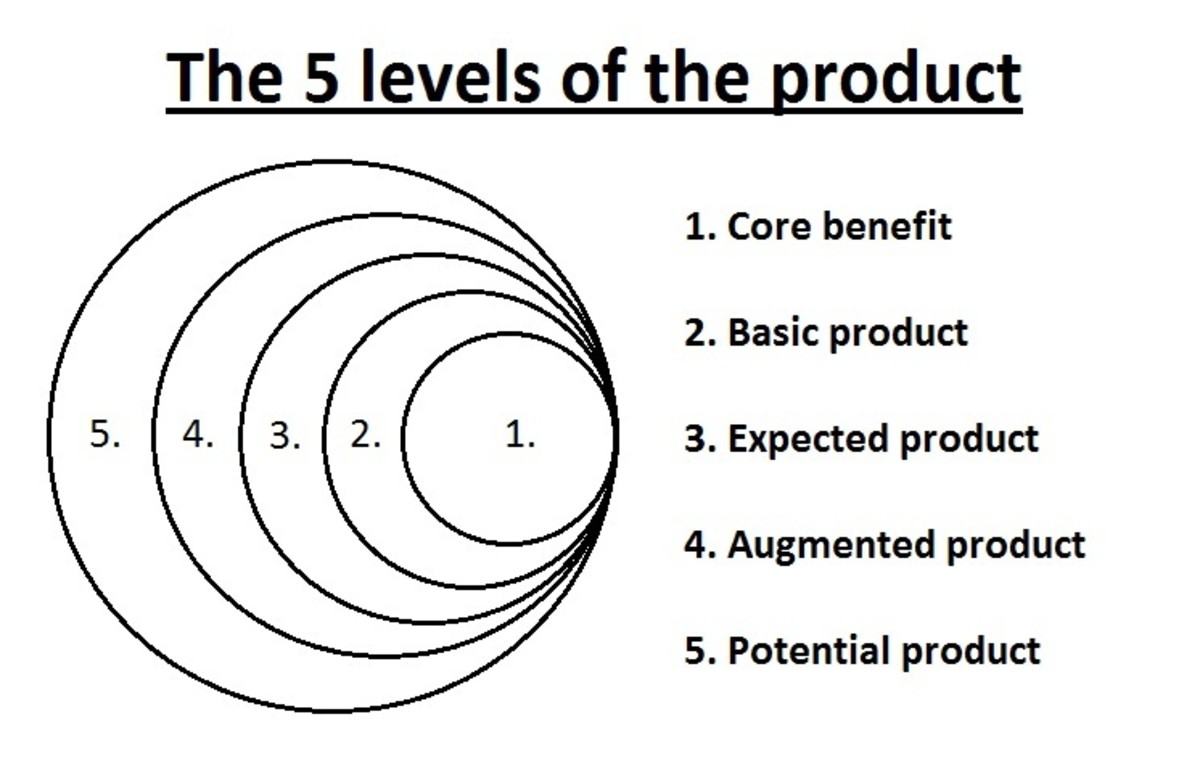What Is Market Positioning of Product?
Positioning - Key to Success
The Key to Customer Preference and Competitive Advantage
Why do customers prefer one product over another? In most cases, consumers or organizational customers choose what they buy for one of two reasons: what they choose is better , in some sense, or cheaper . In case, the good or service they choose is, in some way, almost always different from others they could have chosen. Differentiation is a powerful theme in developing business strategies, as well as in marketing.
Differentiation in Business Strategies
Michael Porter’s classic book on competitive advantage identified three generic strategies: cost leadership, differentiation, and focus, These strategies, which differ in the scope of the target market and market needs they serve and on whether they base their competitive advantage on low cost (lower prices to the customer for equivalent products) or differentiation (products that are superior on some important dimensions) represent distinctly different ways in which companies can compete for the minds and wallets of customers in their target markets. Thus, strategy is implemented at the product market level, where differentiation lies at the heart of positioning.
Differentiation among Goods and Services
Customers in one market segment have wants and needs that differ in some way from those of customers in other segments. Positioning allows the marketer to take advantage of and be responsive to such differences and position particular goods and services so as to better meet the needs of consumers in one or more of these segments
Physical Positioning
One way to assess the current position of a product offering relative to competitors is on the basis of how the various offerings compare on some set of objective physical characteristics. In many cases a physical positioning analysis can provide useful information to a marketing manager, particularly in the early stages of identifying and designing new product offerings. Despite being based primarily on technical rather than on market data, physical comparisons can be an essential step in undertaking a positioning analysis. This is especially true with the competitive offerings of many industrial goods and services, which buyers typically evaluate largely on the basis of such characteristics.
Limitations of Physical Positioning
A simple comparison of only the physical dimensions of alternative offerings usually does not provide a complete picture of relative positions because, as we noted earlier, positioning ultimately occurs in customers’ minds. Consequently, perceptual positioning analysis – whether aimed at discovering opportunities for new product entries or evaluating and adjusting the position of a current offering – is critically important.
Perceptual Positioning
Consumers often know very little about the essential physical attributes of many products, especially household products, and even if they did, they would not understand the physical attributes well enough to use them as a basis for choosing between competitive offerings.
Many consumers do not want to be bothered about a product’s physical characteristics because they are not buying these physical properties but rather the benefits they provide. The evaluation of many products is subjective because it is influenced by factors other than physical properties, including the way products are presented, our past experiences with them, and the opinions of others.
Levers Marketers Can Use to Establish Positioning
Customers or prospective customers perceive physical as well as other differences between goods or services within a product category, of course. Marketing decision makers seeking to win a particular position in customers’ minds will seek to endow their product with various kinds of attributes, which may be categorized as follows:
• Simple physically based attributes.
• Complex physically based attributes
• Essentially abstract attributes.
This is not to suggest that the determinant product attributes and the perceptions of consumers of the various competitive offerings will remain constant across countries or other market segments; rather, they are likely to vary with most products.
Step 1:Identify a Relevant Set of Competitive Products
Positioning analyses are useful at many levels: company, business unit, product category, and specific product line or brand. At the company or business unit level, such analyses are useful to determine how an entire company or business unit is positioned relative to its competitors. The results of such analyses are sometimes displayed graphically by plotting competing companies or businesses in their respective quadrants of the generic strategies grid
Step 2:Identify Determinant Attributes
Positioning can be based on a variety of attributes – some in the form of surrogates that imply desirable features or benefits as a positioning base.
• Features are often used in physical product positioning and, hence, with industrial products.
• Benefits, like features are directly related to a product.
• Parentage includes who makes it and prior products
• Manufacturing process is often the subject of a firm’s positioning efforts.
• Ingredients as a positioning concept is illustrated by some clothing manufacturers’ saying their sports shirts are made only of pure cotton.
• Endorsements are of two types – those by experts
• Comparison with a competitor’s product is common
• Pro environment positioning seeks to portray a company as a good citizen
• Price/quality
Theoretically, consumers can use many attributes to evaluate products or brands, but the number actually influencing a consumer’s choice is typically small, partly because consumers can consider only attributes of which they are aware. The more variables used in positioning a given product, the greater the chance of confusion and even disbelief on the part of the consumer.
Step 3: Collect Data about Customer’s Perceptions for Products in the Competitive Set
Having identified a set of competing products, the marketer needs to know what attributes are determinant for the target market and the product category under consideration. He or she also needs to know how different products in the competitive set are viewed on these attributes.
Step 4: Analyze the Current Positions of Products in the Competitive Set
Whether the positioning process is directed at a new product not yet introduced or repositioning one that already exists, it is important to develop a clear understanding of the positioning of the products that have been determined to be in the competitive set . A useful tool for doing so is the positioning grid, also called a perceptual map. The positioning grid provides a visual representation of the positions of various products or brand in the competitive set in terms of (typically) two determinant attributes.
A brand that is not known by a consumer cannot, by definition, occupy a position in that consumer’s mind. Thus, many if not most brands have little or no position in the minds of many consumers. For example, in the last 10 or so years, more than 200 new soft drinks have been introduced, most of which were not noticed or remembered by consumers. An example of a brand with a strong positioning is BMW and its powerful cars, as the ‘Ultimate Driving Machine’. Determining the attributes on which the product’s positioning will be based is a key outcome of the positioning process and a driver of the marketing communication strategy, as well as the marketing strategy overall, that will ultimately be developed. Without clear guidance about the intended position of the product, advertising agencies, sales forces, and others charged with building the awareness and recognition of the product in the marketplace will be ill equipped to do this important job.
Building a Positioning Grid
Constraints Imposed by an Intense Position
Although marketers should seek a distinctive and intense position for their brands, attaining such a position imposes constraints on future strategies. If shifts in the market environment cause customers to reduce the importance they attach to a current determinant attribute, marketers may have difficulty repositioning a brand with an intensely perceived position on that attribute. Limitations of Product Positioning Analysis product positioning indicate how alternative products or brands are positioned relative to one another in customers’ minds. The problem with this analysis, though, is that it does not tell the marketer which positions are most appealing to customers. Thus, there is no way to determine if there is a market for a new brand or store that might locate in an ‘open’ position or whether the customers in other market segments prefer brands or stores with different attributes and positions. To solve such problems it is necessary to measure customers’ preferences and locate them in the product space along with their perceptions of the positions of existing brands. This is called a market positioning analysis.
Step 5:Determine Customers’ Most Preferred Combination of Attributes. There are several ways analysts can measure customer preferences and include them in a positioning analysis. Another method of assessing customers’ preferences and tradeoffs Among them is a statistical technique called conjoint analysis.14 Customers are surveyed and asked their preferences among various real or hypothetical product configurations, each with attributes that are systematically varied. By analyzing the resulting data, the marketer can learn which of several attributes are more important than the others. These results can then be used in positioning analyses such as those described here.
Step 6:Consider Fit of Possible Positions with Customer Needs and Segment Attractiveness An important criterion for defining market segments is the difference in the benefits sought by different customers. Because differences between customers’ ideal points reflect variations in the benefits they seek, a market positioning analysis can simultaneously identify distinct market segments as well as the perceived positions of different brands. When customers’ ideal points cluster in two or more locations on the product space map, the analyst can consider each cluster a distinct market segment
Step 7:Write Positioning Statement or Value Proposition to Guide Development of Marketing Strategy. The final decision about where to position a new brand or reposition an existing one should be based on both the market targeting analysis discussed in Module 9 and the results of a market positioning analysis. The position chosen should match the preferences of a particular market segment and should take into account the current positions of competing brands.
It should also reflect the current and future attractiveness of the target market (its size, expected growth, and environmental constraints) and the relative strengths and weaknesses of competitors. Such information, together with an analysis of the costs required to acquire and maintain these positions, allows an assessment of the economic implications of different market positioning strategies.
Writing a Positioning Statement or a Value Proposition
A positioning statement is a succinct statement that identifies the target market for which the product is intended and the product category in which it competes and states the unique benefit the product offers.
A value proposition is similarly explicit about what the product does for the customer (and sometimes, what it does not do) and typically also includes information about pricing relative to competitors. Both positioning statements and value propositions should reflect a unique selling proposition that the product embodies. In this sense, they reflect the basis on which the marketer intends to win sustainable competitive advantage by differentiating the product from others in its competitive space. In its shortest form, a value proposition typically looks like this:
• Benefits offered (and not offered)
• Price range (relative to competitors)
More fully developed value propositions sometimes identify the best competing alternatives available to the customer and specify the benefits, in measurable terms, that the customer can expect to receive by using the proposed product.18 Detailed value propositions such as these are particularly helpful in positioning industrial goods and services, where quantifiable customer benefits are often essential to make the sale.
It is important that the positioning statement or value proposition states benefits that the user of the product will obtain, rather than features or attributes of the product itself, or vague or ambiguous platitudes about high quality or excellent service. By benefits, we mean the resulting endues measurable consequences that the user will experience through the use of the product, in comparison to others.
The marketer generally writes positioning statements and value propositions for use internally and by others, such as advertising agencies, engaged to develop the marketing strategy. They are short and succinct, and are typically not written in catchy consumer language, though catchy slogans and tag lines for communication with customers often follow. They are commonly written for a product line or a brand, as is the case in our Volvo example, and sometimes for a single product or for a business as a whole.








